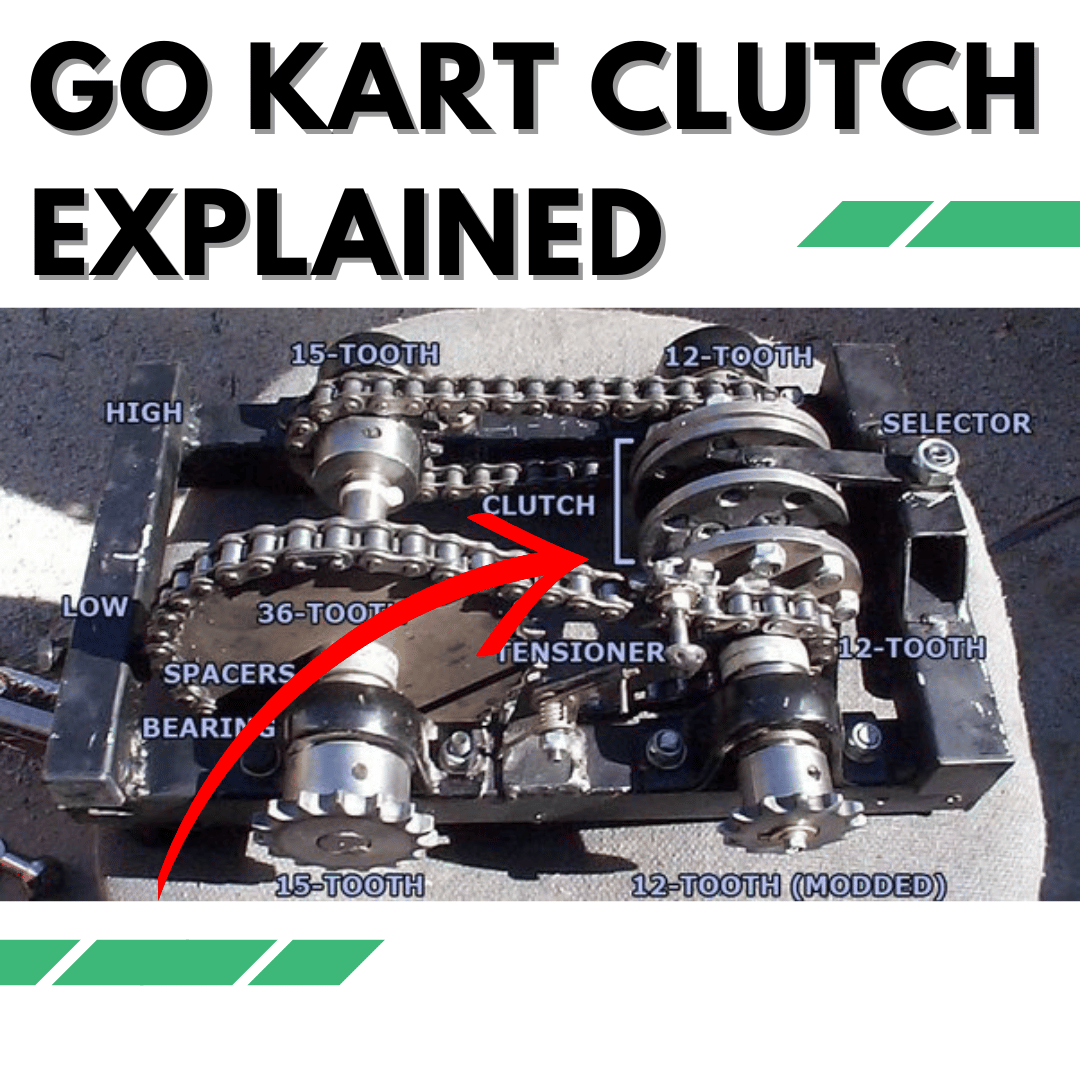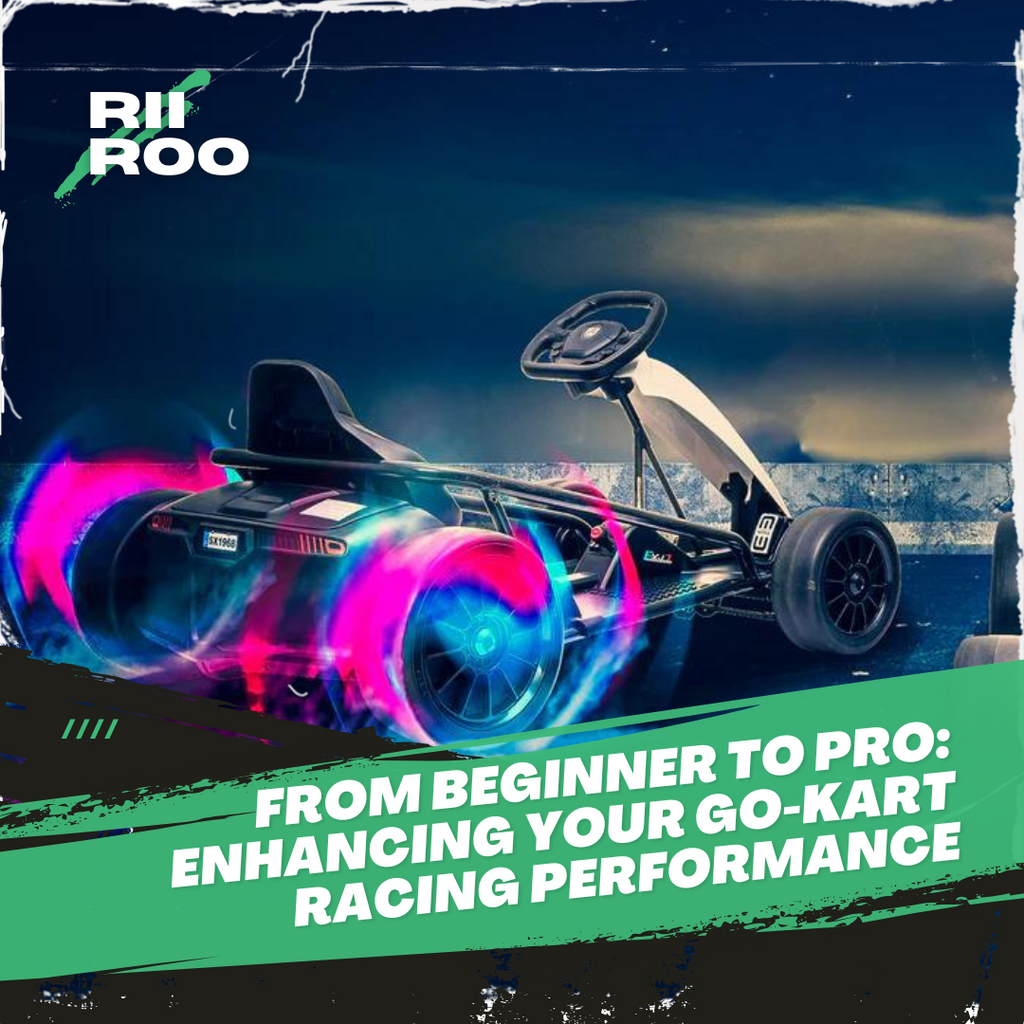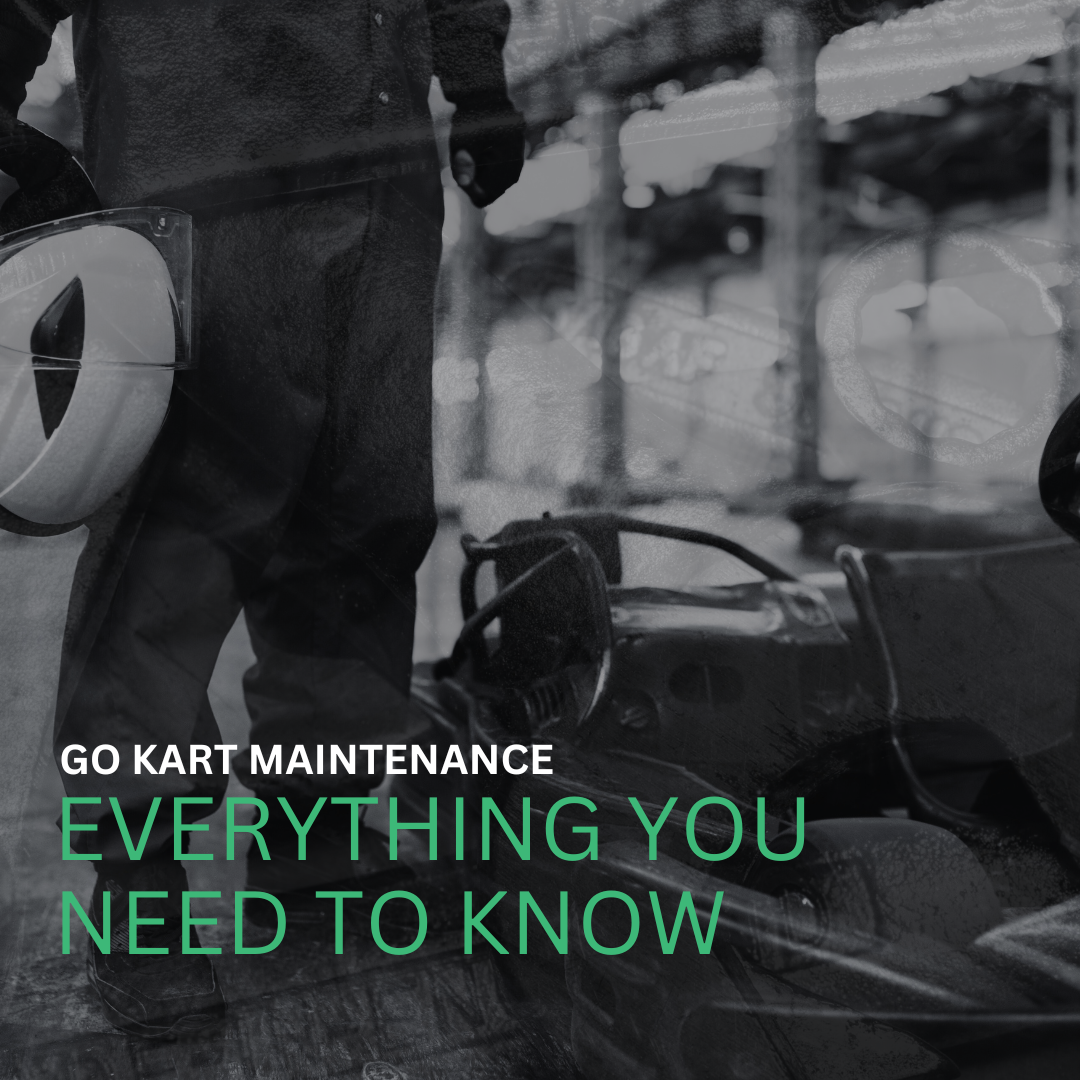Published: 25.7.23
Updated: 21.8.24
Ever zipped down the track in a go-kart, heart pounding, feeling the pure joy of speed, and wondered, "What makes this little machine so powerful?"
There's an unsung hero under your seat – the go-kart clutch. But what if your go-kart clutch starts smoking? 
In that case, you might want to check out this detailed guide about why go-kart clutches smoke for some help.
Imagine the exhilarating rush of speed as you press the accelerator or the elegant glide as your kart eases into motion.
That's the clutch in action, a little piece of genius engineering. It’s like the conductor of an orchestra, unassuming yet pivotal, bringing everything together.
However, mastering the intricacies of a go-kart transmission can significantly improve your overall karting experience.
Intrigued?
Hold on tight as we peel back the layers on the enigma that is the go-kart clutch!
Here’s the short answer to Go Kart Clutch Explained
A go-kart clutch is a vital mechanical component that acts as a bridge, transmitting power from the engine to the wheels, enabling the go-kart to roll and navigate. Typically activated by the engine's increasing RPM, this automatic transmission comprises shoes, springs, and friction lining. Certain go-karts, like shifter karts, utilise a hand clutch for engine startup. The primary function of a go-kart clutch is to disengage and engage the engine from the load it's pulling, thus providing efficient control and power management during the ride.
Understanding the Basics: What is a Go Kart Clutch?
A go-kart clutch can be perceived as the crucial link that bridges the gap between the power of the engine and the wheels roll.
Knowing the right gear ratios for your go-kart can help optimise this power transmission for optimal performance.
Acting as a device for transmitting power, the clutch ensures that the wheels of the go-kart roll smoothly and efficiently.
So, how is this accomplished?
The main components of a go-kart clutch
The basic anatomy of a go-kart clutch includes shoes, springs, and friction lining at the end of the shoes.
Picture this: the drum of the clutch is akin to a well-trained relay racer waiting to receive the baton.
In this case, the baton is the power from the engine, transferred via the shoes and springs of the clutch.
The role of an automatic transmission in a go-kart clutch
The clutch operates using an automatic transmission mechanism. But what does this mean?
Well, imagine if you had to constantly adjust gears manually as you navigated a go-kart track.
Exhausting, right?
The automatic transmission simplifies this process, allowing the driver to focus on the track.
It's activated by the increased revolutions per minute (RPM) of the engine, making it easier to navigate.
Related: Do Go-Karts Have Gears?
Unpacking the Purpose of a Go Kart Clutch
A go-kart clutch is more than just a power transmitter. It serves an essential function that contributes to the overall performance of the kart.
Understanding how to enhance your go-kart racing performance can help you utilise the clutch to its maximum potential.
Engine disengagement and engagement: The core function
The primary purpose of a clutch is to engage and disengage the engine from the load it is pulling.
You can think of it like a clutch in a standard car; when idle, the clutch disengages the engine, allowing it to rest, even while the motor is running.
Ideal conditions for a go-kart clutch
The clutch should not engage when the kart is idle. The manufacturer presets the idle speed of an engine, usually around 1,650 RPM, give or take 200 RPM.
This stipulation means that the clutch, under the right conditions, is designed to last and serve your go-kart efficiently.
Insights on Go Kart Clutch Operation

Every go-kart enthusiast should grasp the operational nuances of the clutch.
Two concepts stand out - the role of RPM and the use of centrifugal force.
The concept of centrifugal force in clutch operation
A go-kart clutch is a centrifugal clutch, an automatic clutch that employs centrifugal force for its operation.
But what is centrifugal force?
Picture swinging a bucket of water over your head without getting wet. The force keeping the water in the bucket?
That's centrifugal force. Similarly, in a clutch, this force pushes out the clutch shoes when the engine RPM increases.
The Role of RPM in clutch engagement
When the RPM increases past the set idle speed, the clutch engages and transfers power to the wheels.
Essentially, an increase in RPM is a signal for the clutch to spring into action.
A typical clutch will come in with six shoes installed, each shoe playing a part in the smooth operation of the clutch.
Tips for Maximising Go Kart Clutch Efficiency
Understanding the principles of clutch operation is key to maximising go-kart performance.
This includes effective go-kart maintenance, which plays a vital role in ensuring a high performing and long lasting clutch.
Here are some tips to help you along the way:
Do’s and don’ts for optimising go-kart speed
It's important not to try to reduce a go-kart's speed by limiting the travel of the petrol pedal or by installing a restrictor in the carburettor to limit full RPM.
These methods can result in the clutch slipping, which is self-destructive.
Instead, the clutch requires full RPM to lock up quickly and start cooling down.
Understanding the importance of correct clutch installation
Just like any other mechanical component, a go-kart clutch must be installed correctly to function effectively.
For instance, go-karts with rear tyres taller than 15" or an engine larger than 8HP need a torque converter instead of a clutch.
Step-by-Step Clutch Installation Guide

-
Prepare the Engine Shaft
- Clean the engine shaft thoroughly.
- Slide the appropriate spacer collar onto the shaft. The collar size depends on your shaft length.
-
Install the Clutch
- Align the key on the clutch with the keyway on the engine shaft.
- Slide the clutch onto the shaft, ensuring it's fully seated.
-
Secure the Clutch
- Insert the retaining bolt through the clutch and into the shaft.
- Use a flathead screwdriver in the clutch slot to prevent rotation while tightening the bolt.
-
Check for Proper Fit
- The crankshaft should be approximately 1/32" longer than the clutch assembly.
- After tightening, you should be able to move the clutch hub back and forth about 1/32" (thickness of a business card).
-
Adjust if Necessary
- If the gap is too large, remove the clutch and add appropriate spacers.
- If the clutch is longer than the shaft, use washers to create the correct gap.
Important Note: For Briggs & Stratton L0206 engines, specific mounting instructions apply. These engines require the clutch to be held tight on the crankshaft, which necessitates a special mounting kit or conversion kit.
By following these steps carefully, you can ensure proper installation and maximise the lifespan of your go-kart clutch.
Remember, improper installation can lead to poor performance and potential safety hazards.
Beginner's Guide: Understanding and Maintaining Your First Go-Kart Clutch
| Beginner's Guide: Understanding and Maintaining Your First Go-Kart Clutch | |
|---|---|
| If you're new to go-karting, understanding your kart's clutch is crucial for both performance and maintenance. This guide will help you grasp the basics and keep your clutch in top condition. | |
| What is a Go-Kart Clutch? | A go-kart clutch is a mechanical device that connects the engine to the drive system. It allows the engine to run while the kart is stationary and smoothly transfers power when you're ready to move. |
| Key Components |
|
| How Does It Work? |
|
| Basic Maintenance Tips |
|
| Signs Your Clutch Needs Attention |
|
| Safety Tips for Beginners |
|
|
Remember, proper maintenance of your go-kart clutch not only ensures better performance but also extends its lifespan. If you're unsure about any aspect of clutch maintenance or notice persistent issues, don't hesitate to consult with a professional mechanic or experienced go-kart enthusiast. |
|
| By understanding these basics and following simple maintenance practices, you'll be well on your way to enjoying a smooth and reliable go-karting experience. | |
Maintaining a Go Kart Clutch: Essential Tips
Maintaining your go-kart clutch is crucial for optimal performance and longevity.
Here are some essential tips and a comprehensive maintenance checklist to keep your clutch in top condition:
Regular Inspection and Cleaning
The accumulation of dirt and debris is a common issue with outdoor go-karts.
Regularly inspect and clean your clutch to prevent this build-up, which can hinder performance.
Replacement of Worn-out Components
Inspect the shoes, springs, and friction linings of your clutch regularly for any signs of wear and tear.
Early detection and replacement of these components can prevent further damage and maintain the efficiency of your go-kart clutch.
Go-Kart Clutch Maintenance Checklist
-
Weekly Checks:
- [ ] Visual inspection for debris or foreign objects
- [ ] Check for any unusual noises during operation
- [ ] Verify proper engagement and disengagement
-
Monthly Tasks:
- [ ] Clean clutch components thoroughly
- [ ] Inspect clutch shoes for wear (replace if less than 1/16" thick)
- [ ] Check springs for proper tension
- [ ] Examine drum surface for scoring or glazing
-
Quarterly Maintenance:
- [ ] Lubricate moving parts with high-temperature grease
- [ ] Inspect and tighten all fasteners
- [ ] Check alignment between clutch and sprocket
- [ ] Measure drum diameter (replace if exceeding manufacturer's specs)
-
Annual Service:
- [ ] Disassemble and deep clean all components
- [ ] Replace worn shoes, springs, and bearings
- [ ] Inspect engine crankshaft seal for leaks
- [ ] Verify clutch engagement RPM
-
As-Needed Maintenance:
- [ ] Adjust engagement RPM if performance changes
- [ ] Replace entire clutch assembly if severe wear is evident
- [ ] Address any unusual vibrations or slippage immediately
By following this checklist and adhering to regular maintenance practices, you can significantly extend the life of your go-kart clutch and ensure consistent performance.
Remember to always consult your specific clutch's manual for any model-specific maintenance requirements.
Inspect the shoes, springs, and friction linings of your clutch regularly for any signs of wear and tear.
Early detection and replacement of these components can prevent further damage and maintain the efficiency of your go-kart clutch.
Recognising Potential Clutch Failures: What to Watch Out For
A malfunctioning go-kart clutch can be a real buzz-killer. To avoid this, it's essential to recognise the signs of a failing clutch and understand what might cause it.
Symptoms of a failing clutch
Common signs of a failing clutch include an increase in engine RPM without an increase in speed, difficulty accelerating, and a burning smell from excessive friction.
If you notice these signs, it might be time for a clutch inspection.
Causes and preventive measures
The lifespan of a go-kart clutch can be drastically reduced by harsh driving conditions, such as driving in sand, on steep terrains, or with excessive weight in the kart.
Avoid these conditions where possible, and ensure that your clutch is installed correctly to extend its lifespan.
Upgrading Your Go-Kart Clutch for Better Performance
As go-kart enthusiasts seek to enhance their vehicle's performance, upgrading the clutch can be a significant step.
Different clutch types and modifications can dramatically improve your go-kart's acceleration, top speed, and overall driving experience.
Types of Performance Clutches
Centrifugal Clutches
- Standard in many go-karts
- Upgrades include:
- Heavier shoes for higher engagement RPM
- Stronger springs for quicker engagement
- Larger diameter for increased torque transfer
Disc Clutches
- Offer more precise control
- Upgrades include:
- Multi-plate systems for increased friction surface
- Sintered metal discs for higher heat tolerance
- Adjustable engagement point for customised performance
Torque Converters
- Ideal for higher-powered karts
- Benefits:
- Smoother acceleration
- Better low-end torque
- Improved top speed potential
Performance Modifications
Clutch Shoe Material
- Upgrading to high-performance materials like kevlar or ceramic can improve durability and heat resistance
Spring Tension Adjustment
- Fine-tuning spring tension can optimize engagement RPM for your specific track or racing style
Drum Surface Treatment
- Applying special coatings or textures to the drum surface can enhance grip and reduce slippage
Cooling Modifications
- Adding vents or cooling fins to the clutch housing can improve heat dissipation, extending clutch life and maintaining performance
Considerations for Upgrading
- Engine Compatibility: Ensure the upgraded clutch matches your engine's power output and RPM range
- Driving Style: Choose upgrades that complement your driving technique and typical race conditions
- Maintenance Requirements: Some high-performance clutches may require more frequent maintenance
- Regulatory Compliance: If racing competitively, verify that your upgrades comply with league regulations
Remember, while upgrading your go-kart clutch can significantly enhance performance, it's crucial to balance improvements with reliability and safety.
Always consult with experienced mechanics or manufacturers when making substantial modifications to your go-kart's drivetrain.
Troubleshooting Common Go-Kart Clutch Problems
Even with proper installation and maintenance, go-kart clutches can sometimes experience issues.
Recognising and addressing these problems early can prevent more serious damage and ensure optimal performance.
Here are some common clutch problems and how to troubleshoot them:
Clutch Slippage
Symptoms:
- Engine revs but kart doesn't accelerate properly
- Burning smell during operation
Troubleshooting Steps:
- Check for worn clutch shoes or springs
- Inspect the drum for glazing or scoring
- Ensure proper engagement RPM setting
- Verify correct clutch size for your engine and kart setup
Overheating
Symptoms:
- Clutch feels hot to touch after use
- Decreased performance over time
- Visible discoloration on clutch components
Troubleshooting Steps:
- Check for proper airflow around the clutch
- Ensure correct engagement RPM to prevent excessive slipping
- Inspect for any debris or oil contamination
- Verify that the clutch is not undersized for your application
Noisy Operation
Symptoms:
- Grinding or rattling sounds during engagement
- Squealing noises at high RPMs
Troubleshooting Steps:
- Inspect for loose or damaged components
- Check for worn bearings in the clutch drum
- Ensure proper lubrication of moving parts
- Verify correct alignment of clutch and sprocket
Premature Wear
Symptoms:
- Frequent need for adjustment
- Visible wear on clutch shoes or drum before expected lifespan
Troubleshooting Steps:
- Check for proper installation and alignment
- Ensure correct clutch size for your engine power
- Verify engagement RPM is set correctly
- Inspect driving habits for excessive slipping or aggressive starts
Clutch Not Disengaging
Symptoms:
- Kart continues to creep forward when engine is idling
- Difficulty starting the engine
Troubleshooting Steps:
- Check for proper idle RPM setting
- Inspect clutch springs for weakness or damage
- Verify correct clearance between shoes and drum
- Ensure no debris is preventing full disengagement
By addressing these common issues promptly, you can maintain your go-kart clutch's performance and longevity.
If you're unsure about any aspect of clutch maintenance or repair, it's always best to consult with a professional mechanic or refer to the manufacturer's guidelines.
In Summary
And there we have it, a full-fledged exploration of the go-kart clutch, the powerhouse behind your thrilling go-kart rides.
We've unravelled how this ingenious device operates, using the engine's rising RPM to set your wheels in motion.
By examining its intricate components, such as the shoes, springs, and friction linings, we've revealed the subtleties that keep your kart running like a dream.
Remember, not all go-karts are created equal. Some rely on clutches or torque converters, while others, like Rotax karts, prefer a direct drive system.
Not to forget the unique shifter karts that employ a hand clutch to kickstart the engine.
Moreover, we've also touched upon the crucial ways to enhance the clutch's efficiency and maintain its longevity, underlining the importance of a well-tended clutch for a smooth, memorable ride.
After all, keeping your go-kart in tip-top shape amplifies the thrill of racing.
Armed with this insight, you are ready to see your next go-karting escapade in a new light, appreciating the humble clutch's key role in your high-octane adventure.
FAQ’s:
What are the different types of go-kart clutches?
Go-kart clutches can be broadly classified into two types - centrifugal clutches and torque converters. Centrifugal clutches are commonly used in small, single-seat go-karts and are activated by the RPM of the engine. On the other hand, torque converters are used in larger, more powerful go-karts and consist of a system of belts and pulleys to manage the power transfer from the engine to the wheels.
What is the difference between a 10-tooth and a 12-tooth clutch?
The primary difference between a 10-tooth and a 12-tooth clutch lies in their gear ratios. A 10-tooth clutch provides a lower gear ratio, meaning it will offer more torque and acceleration but less top speed. Conversely, a 12-tooth clutch has a higher gear ratio, resulting in less torque but a higher top speed. Your choice depends on whether speed or acceleration is more important for your specific go-karting needs.
What speed does a centrifugal clutch engage?
A centrifugal clutch usually engages at a specific RPM rather than a speed. The RPM at which the clutch engages varies based on the design of the clutch and the weight of the springs used. Generally, centrifugal clutches in go-karts engage at around 2,000 to 3,000 RPM.
What is the difference between a go-kart clutch and a torque converter?
A go-kart clutch and a torque converter serve the same fundamental purpose - they transfer power from the engine to the wheels. The difference lies in how they do it. A clutch uses friction to transfer power directly, which is simpler but less efficient for larger engines. A torque converter, on the other hand, uses a system of belts and pulleys to transfer power, which provides more effective power management, especially for larger, more powerful go-karts.











Share:
The 34 Best Go-Kart Racing Tips To Win Races in 2025
Mastering Oversteering: A Vital Defensive Driving Skill